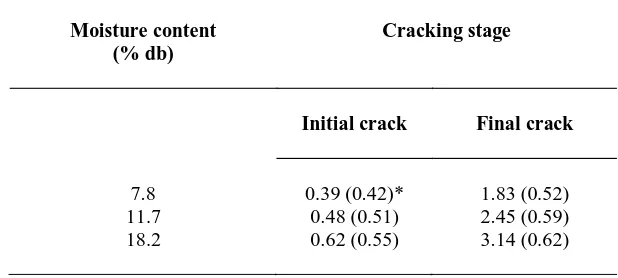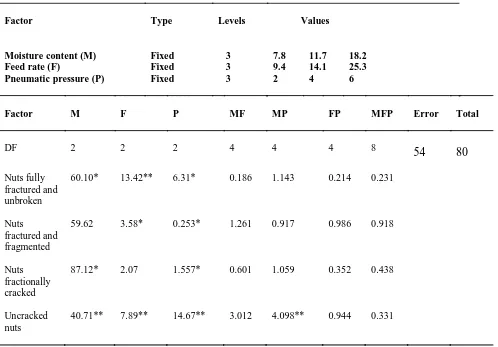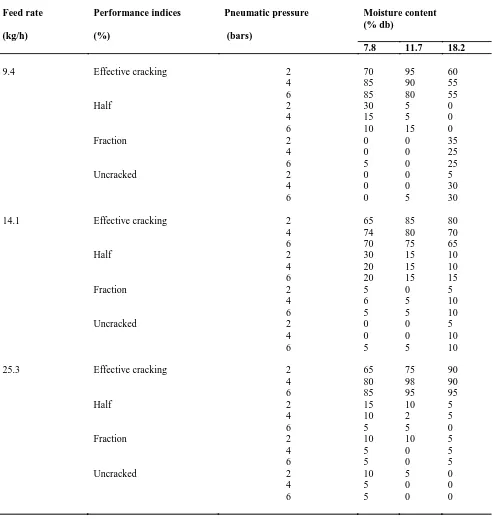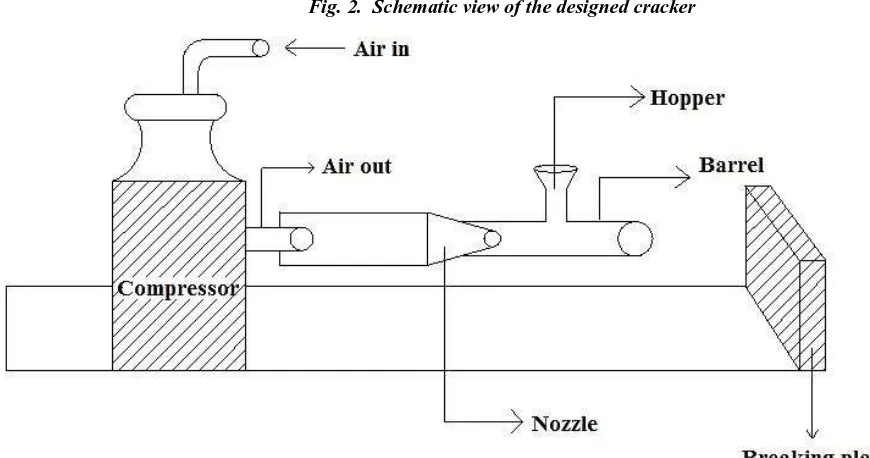International Journal of Applied And Pure Science and
Agriculture
www.ijapsa.com
DEVELOPMENT OF AN ARECANUT (
ARECA CATECHU
L) CRACKER
B. S. Sridhar
Department of Food Engineering, Central Food Technological Research Institute, Mysore – 570 020
Abstract
An Arecanut (Areca catechu L) prototype cracker was developed and tested. The cracker, comprises a rectangular convergent feeding zone, nozzle system, breaking plate, collector, powered by compressor arrangement. The equipment was conceived to split the shell and kernel of arecanuts through force by air pressure. Performance evaluation showed the moisture level and the rate of feeding of arecanuts and pneumatic pressure had significant effect at different levels on cracker's efficiency. Evaluation of chemical composition showed no significant (P>0.05) difference between cracked and uncracked samples. Based on the range of selected parameters the highest performance of the cracker was found to be the moisture level of 11.7% (db), feed rate, 25.3 kg/h and pneumatic pressure of 4 bars. The estimated capacity of the machine was 25.3 kg/h. The cracker does not require sizing of nuts prior to cracking, eliminating the laborious, time consuming current cracking methods.
Keywords: Arecanut; Cracking; Pneumatic force impact; Nuts; Fracture
I. INTRODUCTION
Arecanut (Areca Catechu L), is the traditionally acknowledged chewable food product with the Asian population [1]. It is commonly identified as 'betel nut', 'kali pak' and 'parcha'. It has applications as human and animal medicine having antibacterial and antiviral activity and is used in the paint and leather industries [2,3,4,5,6,7]. Areca nut has been cultivated as a cash crop in the Asian continent and about 16 million people are dependent on arecanut industry for their livelihood in India [8]. India is the leading country contributing to around 51% of world’s areca nuts production of amounting to 0.47 million tonnes of nuts annually followed by China with 25% share [9,10].
Arecanuts have inferior storage quality and its casings are tough to split without an appropriate machinery. Breaking the casing surrounding the kernel is the main cost intensive task in the processing of arecanuts, mainly due to unsatisfactory retrieval of kernels as a result of uncracked, or incompletely cracked nuts. The present method of cracking the nut includes physical breaking with hammer, knife cutter and stones. This process is strenuous, inefficient and injury prone. As a result, the splitting process has bestowed an impediment to arecanuts handling. Many machines have been developed for cracking similar materials such as conophor nuts, melon seeds, walnuts, macadamia and shea nuts [11,12,13,14,15,16,17].In spite of this development the majority suffer from poor recovery of kernels leading to significant losses.Thus there is a need to develop a nut cracker to overcome the tediousness of the operation, reduce losses, improve kernel recovery as well as for its obvious commercial importance.
II. MATERIALS AND METHODS
A. Arecanuts
Arecanuts, South Kanara variety cultivated in the Central Plantation Crops Research Institute Kasaragod, Kerala, India were used in the study. The moisture contents of arecanut samples (25 numbers) were estimated by the AOAC [18] method. The resulting moisture levels of nuts were 7.8%, 11.7% and 18.2% dry basis (db). The dehydrated samples were kept at 4 C and 60-62% relative humidity in compact polyethylene pouches till the completion of the experiments. Samples were clearly examined for any cracks ahead of deformation tests and the particular defective nuts were rejected. Before the cracking test, nuts were visually inspected and those with damaged shells were discarded. Figure 1 depicts the structure of the dry arecanuts.
B. Chemical Composition
The arecanuts were analyzed for chemical composition: total fat by acid hydrolysis (method 948.15), ash by direct analysis (method 938.08) according to AOAC [19] procedures. To investigate the probable incidence of protein degradation due to impact, the protein content in cracked and uncracked arecanuts was estimated by Lowry's method [20]
C. Physical and Mechanical Characteristics
The optimum processing of breaking of arecanut kernels depends upon a few primary details on the physical and mechanical properties and load-deformation history related to splitting mechanism [21]. The physical dimensions were determined randomly measuring length, width and thickness (in mm) of 30 nuts by a digital caliper (Mitutoyo; Japan; least count 0.01 mm). To obtain the unit mass, each nut was weighed with an electronic balance (Contech Instruments Ltd, Bombay, India) to a sensitivity of 0.001 g.
The equivalent diameter as the geometric mean of the three dimensions was calculated using the following expression [22]. The geometric mean of length, width and thickness expressed as 'Equivalent diameter' was determined by applying the formulation developed by Mohsenin [22] as:
Dg = (LWT) 1/3 (1)
where Dg, the geometric equivalent diameter. The criteria used to describe the shape of the nuts was the
sphericity (Ø) and was computed using the equation [22]
Ø = [Dg / L] x 100 (2)
The mechanical behaviour of the arecanuts were analyzed by means of deformation experiments employing " Universal Testing Machine" (Model - 5580; Instron India Pvt. Ltd. Chennai, India). The nuts were subjected to gradual increasing axial compressive load and continued till the samples go through initial and complete fracture. Alternative deformation measurements such as extension, deflection involving different loading pattern were not undertaken as arecanuts had the shapes more or less of a sphere and isotropic.
Based on the cracking data the minimum pneumatic pressure required to crack the nut was computed as [23] :
Pmin = 2 F/A (3)
where Pmin is the minimum pneumatic pressure required to crack the nut in bars, F, the force required in
Newtons and A, area of nut in mm2
D. Prototype Machine Description
The development of the arecanut cracker was based on a hypothesis that pneumatic force collision disintegrates shells and continuous uniform dislocation results in enhanced breakage. Similar studies involving mechanical stresses have been carried out for macadamia nuts [24] and pea nuts processing.[25]. Figure 2 shows the schematic view of the equipment developed. The machine comprises six major components assembled together. The cracking unit consists of the frame, a hopper, nozzle, breaking plate, pneumatic system and a collecting bin.
The frame: The cracking unit is bolted firmly to the frame. The stand is made from ms plate (700 mm long, 178 mm wide and 127 mm thick). The entire surface of the machine was painted to prevent corrosion and rusting.
The hopper: The hopper is rectangular in cross section at the top converging towards the bottom fixed at centre of the cracking unit and reinforced through a rigid base structure. (Major diameter 40mm and minor diameter 26 mm; hopper angle 75.42°)
The nozzle unit: The nozzle unit comprises a cylindrical housing attached to the compressor through a cylindrical polyethylene tube 280 mm long and 25 mm in diameter. A breaking plate 118 mm long, 127 mm wide and 20mm thick is placed at distance of 450 mm. The arecanut ejects from the polyethylene tube with sufficient force enough to get broken after its impact with the plate.
The pneumatic system: It is an air compressor system with an operating pressure of maximum 8 bar and a power input of 0.25 kW to provide variable air pressure to control the cracking force for impacting nuts. Arecanuts eject out of the barrel tubing of the cracking unit with a cracking force to be impacted against the breaking plate.
The collecting bin: The cracked arecanuts are fallen and collected at this part.
E. Performance Evaluation
In order to assess the functioning of the equipment the hopper gate slots conveying different output of nuts to nozzle unit was established initially through a feeding device (Model 44621; AEG, Germany). A graduation scale was employed regulating the percentage of slot specified by the marking ranging from 20 to 100 %. The feeding zone was loaded with arecanuts and the mandrel attached was fine-tuned to interpret slot corresponding to 20 %. The nuts were let in run without any restraint past hopper opening and the duration to deliver 30 nuts was obtained. The procedure was replicated at other gap percentages. The amount of nuts discharging out of hopper gate was assumed as material input and determined as [26] :
Nr = W / t (4)
where Nr amount of nuts discharged in kg/h, W weight of nuts in kg, t duration (in h) for nuts delivery
from the hopper opening.
The throughput capacity was calculated using the same Equation (4) as mass of nuts leaving the machine after cracking per unit time, expressed in kg/h
adjusting the flow controller to a specific discharge output. The quantity of fully fractured, fragmented and undivided, partially fractured, fragmented and undivided and undivided nuts were obtained after every trial. The experiments were conducted at different feed rates and t pneumatic pressures.
The functioning of the equipment was assessed through the following efficiency indicators:
Percentage actual fracture:
Df ≈ [N1 / Nt] x 100 (5)
Percentage of half breakage :
Db ≈ [N2 / Nt ] x 100 (6)
Percentage fractionally cracked:
Dc ≈ [N3 / Nt ] x 100 (7)
Percentage of uncracked nuts:
Du ≈ [N4 / Nt ] x 100 (8)
where N1,thenumber of nuts fully fractured and undivided, N2, thenumber of nuts fully fractured and
fragmented, N3, thenumber of nuts partially fractured and fragmented, N4, the number of undivided nuts
and Nt, the total number of nuts.
F. Statistical Analyses
A 3x3x3 factorial design was employed for the tests. The process parameters were: (i) moisture levels of nuts - 7.8, 11.7, and 18.2% (db); (ii) feed rates - 9.4,14.1 and 25.3 kg/h; (iii) pneumatic pressure - 2,4 and 6 bars. The effect of these parameters were statistically examined by performing ANOVA tool of the Statistical Analysis System [27] and reported as average of three replications.
III. RESULTS AND DISCUSSION
A. Chemical Composition
Results of chemical composition analysis showed protein, fat and ash content percentage of uncracked and pneumatically cracked arecanut samples, expressed as mean ± SD (n=3) were 5.6 ± 1.1 and 5.5 ± 0.9, 5.2 ± 1.4 and 5.4 ± 1.3, 1.2 ± 0.3 and 1.3 ± 0.4 respectively. Protein, fat and ash contents did not differ significantly (p > 0.05) between cracked and uncracked samples.
B. Material Characteristics
A few material characteristics of arecanut that effect the design, process and functioning of the cracker such as length, width, thickness, geometric mean diameter and mass are presented in Table 1 for three moisture conditions. The shape values of nuts ranged between 0.770 to 0.778 and were regarded as closer to sphere [22].
instantaneous loading, the pressure in the range of 2 bars and above to cause the failure of the arecanut was considered in the present study.
C. Performance Tests
The outcome of the analyses carried out on the functioning of the cracker are shown in Tables 3 and 4. As seen from the Table 3, at 1% level of significance, moisture level, feed rate and pneumatic pressure had considerable impact on fully fractured and fragmented, and fractionally cracked nuts. Partially fractured nuts had no considerable impact on feed rate. Similarly at 5% level moisture level, feed rate and pneumatic pressure and interaction between moisture and pneumatic pressure had significant impact on uncracked nuts.
Considering Table 4 it was observed that moisture level, feed rate and pneumatic pressure of the nuts that yielded optimum working of the equipment was 11.7% (db), 25.3 kg/h and 4 bars respectively. At 25.3 kg/h feed rate and with every pneumatic pressure applied, there was an increase in actual fracture percentage whereas the percentage half breakage decreased with increase in moisture level. The percentage fractionally fractured and uncracked nuts almost remain constant. These variations in responses may be attributed to differences in material characteristics of arecanut and operational parameters of the machine. The throughput capacity of the machine calculated as mass of nuts leaving the machine after cracking per unit time calculated from Equation (4), was found to be 25.3 kg/h.
IV. CONCLUSIONS
A prototype arecanut cracking machine was developed operating on the principle of impact using pneumatic force. The protein, fat and ash contents were found to be not significantly (P > 0.05) different between the cracked and uncracked arecanut samples. The performance tests of cracker based on the range of selected settings showed that the highest performance of the machine was found to be the moisture content of 11.7% (db), feed rate, 25.3 kg/h and pneumatic pressure of 4 bars. The machine has a compact design and does not require sizing of nuts prior to cracking, eliminating the laborious, time consuming current cracking methods. The estimated capacity of the machine was about 25.3 kg/h.
Incorporating flow control device and a sensor at the base of the hopper can significantly increase the productivity of the cracking machine. By conducting studies with different hard to crack nuts like almond, walnuts and macadamia nuts and solving separation between kernels and shells, the machine can be used as an inexpensive tool for the growers.
BIBLIOGRAPHY
[1] Trease K Evan, W.C. 2009; Pharmacognosy15th Ed.; Elsevier, Noida, pp.619-637.
[2] Lalithkumari, H. and Sirsi, M. 1965, Antibacterial antifungal activity of areca catechu linn., Indian Journal of Experimental Biology, 7: 66-69.
[3] Sastry, J.L.N. 2005. Dravyaguna Vijnana. Fundamental Principles of Pharmaco-therapeutics in Ayurveda. Vol. 2; Chaukhambha Orientalia, Varanasi, India, pp. 315-838.
[4] Dhinegra, D. and Sharma, A. 2006. A review on antidepressant plants, Nature products radiance; National institute of science, communication and information resources. New Delhi, India, pp. 146-168.
[5] Azeez, S.; Amudhan, S.; Adiga, S.; Rao, N.and Laxminarayana, A. 2007.Wound healing profile of Areca catechu ex-tracts on different wound models in Wistar rats. Kuwait Medical Journal, 39 (1): 48-52.
[6] Michael, A. 2009. Study on the Arecanut for its antimicrobial properties. Pharmacognosy, 1(1): 42-45.
[7] Reena R.; Authikat, N.; Ravi, B. and Sujatha, S. 2007. Soil fertility status as influenced by arecanut based cropping system and nutrient management. J Plantation Crops, 35(3):158-165.
[9] FAO. 2010. FAO statistics; Food and Agricultural Organization. Rome, Italy.
[10] GOI. 2011 Agricultural Statistics at a Glance; Directorate of Economics and Statistics, Ministry of Agriculture, Govt of India, New Delhi, India, pp.1-482
[11] Makanjuola, G.A. 1975. An evaluation of some centrifugal impaction devices for shelling melon seeds. Journal of Agricultural Engineering Research 20: 71–77.
[12] Makanjuola, G.A. 1978.A machine for cracking conophor nuts. AppropriateTechnology, 5(1): 21–22. [13] Odigboh, E.U. 1979. Impact egusi shelling machine. Transactions of the ASAE, 22(6):1264-1269.
[14] Sarig, Y., Grosz, F. and Rasis, S. 1980. The development of a mechanical cracker for Macadamia nuts. Journal of Agricultural Engineering Research,25:367– 374.
[15] Olajide, J.O.; Ade-Omowaye, B.I.O.and Otunola, E.T. 2000. Some physical properties of Shea Kernel. Journal of Agricultural Engineering Research, 76 (4): 419-421.
[16] Aviara, N.A. and Haque, M.A 2001. Moisture dependence of thermal properties of sheanut kernel. Journal of Food Engineering, 47 (2): 109–113.
[17] Aviara, N. A.; Haque, M. A. and Izge, I. A.2002. Physical properties of sheanut (Butyrospernum paradoxum) in relation to bulk handling and processing. Ife Journal of Technology, 73 (1): 105–111
[18] AOAC. 1995. Official Methods of Analysis16th Ed.; Association of Official Analytical Chemists. Arlington, USA . [19] AOAC. 1990. Official Methods of Analysis15th Ed.; Association of Official Analytical Chemists, Arlington, USA . [20] Lowry, O.H.; Rosebrough, N.J.; Farr, A.L and Randall, R.J. 1951. Protein measurement with the Folin phenol reagent.
J. Biol. Chem., 193 (1): 265–75
[21] Correˆa, P.C.; Schwanz da Silva, C.; Jaren, P.C. and Afonso Ju´nior, I.A. 2007.Physical and mechanical properties in rice processing. Journal of Food Engineering, 79: 137-142.
[22] Mohsenin, N.N. 1986. Physical Properties of Plant and Animal Materials, Structure, Physical Characteristics and Mechanical PropertiesVol.1; Gordon and Breach, London, pp. 128 -337.
[23] Mahadevan, K. and Balaveera Reddy, K. 1996. Design Data Hand Book; CBS Publishers. New Delhi,India, pp.453. [24] Liang, T.; Mehra, S.K. and Khan, M.A. 1989. A macadamia nut curing system for improving kernel recovery. Journal
of Agricultural Engineering Research, 43: 103-111.
[25] Evans, M.D.; Holmes, R.G and Mcdonald, M.B. 1990.Impact damage to system seed as affected by surface hardness and orientation. Transactions of the ASAE, 23(1): 234-240.
[26] Ndukwu, M.C. and Asoegwu, S.N. 2011. A mathematical model for predicting the cracking efficiency of vertical-shaft centrifugal palm nut cracker. Res. Agr. Eng., 57 (3): 110–115.
Table 1 - Physical properties of arecanut Moisture content (% db) Length (mm) Width (mm) Thickness (mm) Mass (g) Geometric mean diameter (mm) Sphericity
7.8 28.10 (2.41)* 20.63
(1.52)
19.21 (1.60)
72.92 (1.76)
21.65 0.770
11.7 28.12 (2.38) 20.65
(1.65)
19.24 (1.79)
101.16 (2.29)
21.67 0.771
18.2 29.16 (2.69) 20.84
(1.67)
21.16 (1.72)
147.96 (2.61)
22.70 0.778
* Values in parenthesis represent standard deviation
Table 2 - Average deformation values (mm) of arecanut cracking process
Moisture content (% db)
Cracking stage
Initial crack Final crack
7.8 0.39 (0.42)* 1.83 (0.52)
11.7 0.48 (0.51) 2.45 (0.59)
18.2 0.62 (0.55) 3.14 (0.62)
Table 3- F values for arecanut cracker performance tests
Factor Type Levels Values
Moisture content (M) Fixed 3 7.8 11.7 18.2
Feed rate (F) Fixed 3 9.4 14.1 25.3
Pneumatic pressure (P) Fixed 3 2 4 6
Factor M F P MF MP FP MFP Error Total
DF 2 2 2 4 4 4 8 54 80
Nuts fully fractured and unbroken
60.10* 13.42** 6.31* 0.186 1.143 0.214 0.231
Nuts
fractured and fragmented
59.62 3.58* 0.253* 1.261 0.917 0.986 0.918
Nuts fractionally cracked
87.12* 2.07 1.557* 0.601 1.059 0.352 0.438
Uncracked nuts
40.71** 7.89** 14.67** 3.012 4.098** 0.944 0.331
Table 4 - Performance results of arecanut cracker Feed rate (kg/h) Performance indices (%) Pneumatic pressure (bars) Moisture content (% db)
7.8 11.7 18.2
9.4 Effective cracking 2 70 95 60
4 85 90 55
6 85 80 55
Half 2 30 5 0
4 15 5 0
6 10 15 0
Fraction 2 0 0 35
4 0 0 25
6 5 0 25
Uncracked 2 0 0 5
4 0 0 30
6 0 5 30
14.1 Effective cracking 2 65 85 80
4 74 80 70
6 70 75 65
Half 2 30 15 10
4 20 15 10
6 20 15 15
Fraction 2 5 0 5
4 6 5 10
6 5 5 10
Uncracked 2 0 0 5
4 0 0 10
6 5 5 10
25.3 Effective cracking 2 65 75 90
4 80 98 90
6 85 95 95
Half 2 15 10 5
4 10 2 5
6 5 5 0
Fraction 2 10 10 5
4 5 0 5
6 5 0 5
Uncracked 2 10 5 0
4 5 0 0
Fig. 1. The dried arecanuts



